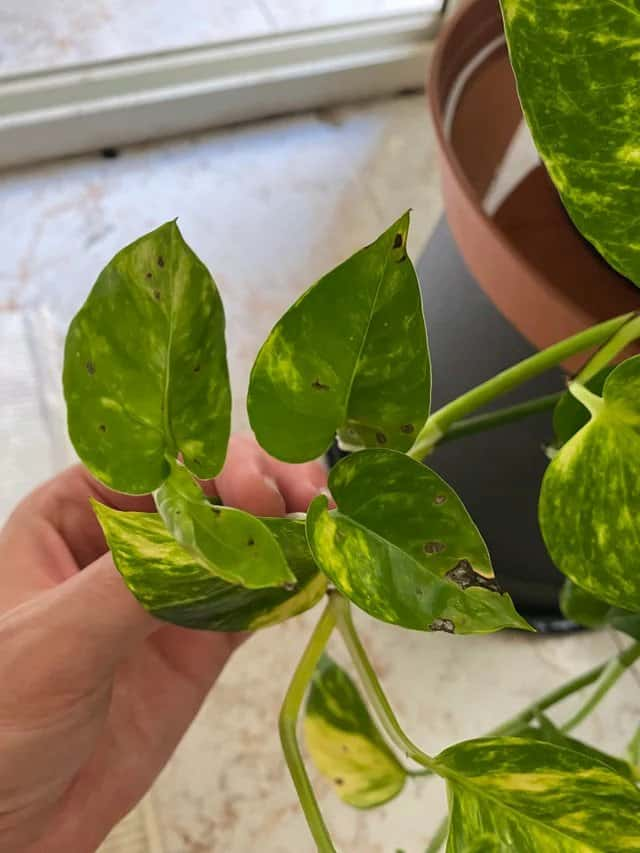If you have a pothos plant that’s started to develop some odd coloring on its leaves, then it’s completely understandable that you may be wondering what exactly is causing it. This is especially if you’ve noticed spots on its leaves which are rudely interfering with the pothos’ normal gorgeous coloring!.
Unfortunately, there’s a good chance that you may have bacterial leaf spot on your pothos. Don’t worry, it’s not the end of the world, but it’s always better to catch these things early so that you can take action accordingly.
So with that in mind, this article will tell you everything you need to know about this disease, including how to treat it!

Table of Contents
What does bacterial leaf spot on pothos look like?
When the bacterial leaf spot on pothos first appears, you will notice small, water-soaked spots on the leaves of your pothos plant. These spots will eventually turn brown or black and may be surrounded by a yellow halo. The leaf tissue around the spots may also begin to die.
In addition to the characteristic spots that can be found, there may also be brown or black lesions around the edge of the leaf. This could lead to your pothos’ leaves curling, flaking, or parts of the leaf’s edge breaking or crumbling off.
The texture of the leaves will also change, becoming rough or corky. Your pothos leaves may droop, with the wilted appearance being most noticeable in the morning hours. The leaves won’t be as perky as they once were and the plant may become leggy and less dense than before.
You may also notice that the leaves of your plant are dropping off more than usual. This is especially true if the disease is severe and goes untreated for an extended period of time.
In extreme cases, the bacterial infection will reach the stem, causing it to look black and sunken in. The stem may also ooze a sticky substance. This indicates that the plant is in serious trouble and will likely not recover if it’s not treated immediately.
How do you treat bacterial leaf spot on pothos?
Treating bacterial leaf spots is not difficult, but it does require consistent effort. The first step is to isolate the plant since this infection is contagious and can affect other plants in your home. Once the plant is isolated, you will need to remove all of the affected leaves, which is necessary to prevent the infection from spreading.
After you have removed the affected leaves, you will need to disinfect your pruning shears. This is important because you don’t want to spread the infection to other plants.
The next step is to treat the plant with an antibacterial substance such as neem oil – I prefer PetraTools Pure Neem Oil (check the current price here). Neem oil works by suffocating the bacteria, which will kill it and prevent it from spreading.
Once you have treated the plant with neem oil, you will need to continue to monitor it for any new signs of infection while keeping it isolated. Make sure that you keep the temperature on the cooler side, lessen the humidity in the environment, and limit watering. These steps should help you treat bacterial leaf spot on pothos and prevent it from spreading to other plants in your home.
The sooner you catch and treat this disease, the better. If you wait too long, the plant may not recover and will eventually die. So, if you see any signs of bacterial leaf spot on your pothos plant, don’t hesitate to take action!
How do you distinguish fungal leaf spot from bacterial leaf spot on pothos?
It can be very hard to distinguish fungal leaf spot from bacterial leaf spot on pothos because they generally look the same. However, looking for fungal structures, which are generally small round, black spots with a white halo, on the underside of the leaf can help.
Powdery mildew, mold, and signs of rust also indicate a fungal infection.
Both organisms are difficult or impossible to see with the naked eye, so a magnifying glass or microscope may be necessary. If you’re still unsure, it’s best to consult with a professional who can help you properly identify the infection and determine the best course of action.

How to prevent bacterial leaf spot on pothos
In order to prevent bacterial leaf spot infections, it’s important to take good care of your pothos clipping. Clippings are the most common way that this disease is spread, so it’s crucial to get yours from a healthy plant and use sterilized materials to avoid infecting your own.
Don’t overwater your pothos or over-mist your plant because too much moisture will create the perfect environment for bacteria to thrive. Make sure that your plant has good airflow and isn’t placed too close to other plants, which could also spread the infection.
The best soil for pothos is one that’s well-draining, although it’s also important to make sure that the pot has drainage holes to prevent the roots from sitting in water. You can do this by using soil that has perlite or sand added to it or by adding crushed clay pieces or rocks to the bottom of the pot.
Best soil for Pothos
Miracle-Gro Tropical Potting Mix
Light and well-draining (perfect for avoiding root rot) while being packed with just the right nutrients – that will feed your plant for up to six months. The best soil for keeping your pothos healthy and strong.
Finally, keep an eye on your pothos plant. The best form of prevention is early detection, so if you see any signs of infection, take action immediately.
These simple steps will go a long way in preventing bacterial leaf spots on pothos and keeping your plants healthy!

